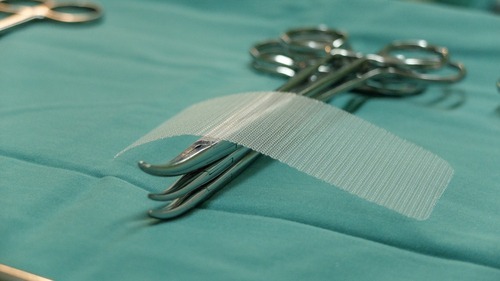W.L. Gore & Associates (Gore) is one of the largest privately held companies in the United States and does business creating products from its breathable and waterproof material called Gore-Tex. Gore Medical, an expansion of the company makes various medical devices with the Gore-Tex material, such as its Gore-Tex DualMesh. The Gore-Tex hernia mesh was approved by the U.S. Food and Drug Administration (FDA) in 1995 but has since been identified as a mesh product that can fail and cause injuries.
If you had a hernia repair surgery and Gore-Tex DualMesh was used, you may have suffered hernia mesh injuries from your surgery like so many others.
The personal injury attorneys at the Shouse Law Group are here to represent injured clients and inform you about the risk and complications associated with Gore products.
- 1. What is hernia mesh?
- 2. What is Gore-Tex DualMesh?
- 2.1 What is it made of?
- 2.2 Is Gore-Tex DualMesh still in use?
- 3. How was Gore-Tex DualMesh approved by the FDA?
- 4. Are there any side effects or complications?
- 4.1 What is adhesion?
- 4.2 What is chronic pain?
- 4.3 Can I get an infection from Gore-Tex DualMesh?
- 4.4 What is a seroma?
- 4.5 What is bowel perforation?
- 5. Can I be compensated for my injuries?
- 6. What do I do if I was injured by Gore-Tex DualMesh?

1. What is hernia mesh?
Hernia mesh is a screen-like medical mesh that provides support to damaged and weakened tissue caused by a hernia. A hernia is a bulging of an organ or tissue through an abnormal opening.
Hernia mesh is intended to prevent the recurrence of your hernia. But defective hernia mesh leads to thousands of patients suffering complications every year. There are many types and classifications of hernia mesh that a surgeon may use, each with its own benefits and complications.
2. What is Gore-Tex DualMesh?
Gore-Tex DualMesh is a hernia mesh designed with a rough and smooth side. The smooth side is meant to prevent adhesions to internal organs while the rough side is intended to promote incorporation into the wall of the abdomen. Sadly for patients, the mesh has created serious complications.
2.1 What is it made of?
Gore-Tex DualMesh is made entirely of ePTFE, trademarked as Gore-Tex. DualMesh is unlike many other synthetic mesh products that are made from plastic-like polypropylene. Some studies have shown that synthetic meshes are more likely to result in complications after hernia mesh surgery. 1
The pores in the hernia mesh stretch, creating a porosity of around 70%. This high porosity has been shown to foster significant bacterial growth.
2.2 Is Gore-Tex DualMesh still in use?
Gore-Tex Dual Mesh has been marketed since its approval in 1995, but over the years Gore Medical became aware of the complications caused by its defective hernia mesh. Most surgeons no longer use Gore-Tex Dual Mesh because they know of these complications. Gore Medical continues to market its product despite its problems.
However, this product may have been used to treat your type of hernia, and if so, you could be facing the same complications faced by so many others.
3. How was Gore-Tex DualMesh approved by the FDA?
Gore-Tex DualMesh was approved by the FDA through the 510(K) Premarket Approval Program. This means that this hernia mesh did not go through rigorous medical testing to determine whether it was effective or safe. Gore Medical was only required to show that Gore-Tex Dual Mesh was as safe and effective as similar devices on the market. 2
This program is highly criticized and has allowed defective mesh models to enter the market and be used on patients.
4. Are there any side effects or complications?
There are many different side effects and complications that can result from a surgeon’s use of defective Gore-Tex DualMesh or from the doctor’s own negligence. These can range from minor and short-lived to severe and long-lasting.
4.1 What is adhesion?
Gore-Tex Dual Mesh is known to cause adhesion, which occurs when scar tissue forms around the mesh implant and joins the implant with other internal tissue or organs. This can occur within a few weeks of your surgery or can take months or years.
4.2 What is chronic pain?
Pain after surgery for a short period is normal as your body heals. Severe pain or pain which lasts for longer than 3 months (chronic pain) is not normal and may be caused by defective Gore-Tex Dual esh.
Chronic pain is debilitating, taking away your ability to live a normal and enjoyable life.
4.3 Can I get an infection from Gore-Tex DualMesh?
Many patients develop infections after surgery with Gore-Tex DualMesh. This can be caused by an allergic reaction to the mesh, improper sterilization of the mesh, or malpractice by your surgeon. Infections can cause pain and delay your healing. They can be life-threatening in extreme circumstances.
The rough side of Gore-Tex DualMesh is known to allow bacterial colonies to grow more easily than the smooth side. The bacteria then causes the mesh to degrade, causing further infection complications. 3
4.4 What is a seroma?
A seroma is a collection of fluid, called serum, that builds up under the surface of the skin. They can develop where surgical incisions were made in the body or where bodily tissue was removed. These commonly occur after a significant surgical procedure such as a hernia repair and can be the result of defective hernia mesh.
4.5 What is bowel perforation?
Gore-Tex DualMesh models are also known to cause bowel perforation. Perforation occurs when the mesh penetrates the lining of your internal organs or other bodily tissue.
Perforation of organs such as your bowel is extremely serious, leading to severe pain, infection, and long-term complications.
5. Can I be compensated for my injuries?
If you have suffered injuries as the result of defective Gore-Tex DualMesh, you may be entitled to financial compensation for:
- Past and future medical bills
- Lost wages or loss of earning capacity
- Pain and suffering
- Punitive damages (in certain circumstances).

6. What do I do if I was injured by Gore-Tex DualMesh?
You are not responsible for hernia mesh failure, especially if it was due to a defect. Typically, the manufacturer of defective mesh products are the responsible parties. Through your personal injury attorney, you can file a claim or hernia mesh lawsuit to obtain compensation for any and all damages you suffered.
We have local offices throughout California, but we represent clients throughout the U.S. who have been injured by hernia mesh products.
If you or someone you know has been harmed by a doctor, nurse, or other healthcare provider’s negligence or by a defective medical product, contact our lawyers today for a free consultation. Call us or fill out our online contact form on this page.
References
- MDPI. Past, Present and Future of Surgical Meshes: A Review
- FDA. Premarket Notification 510(K)
- NCBI. An in vitro study assessing the effect of mesh morphology and suture fixation on bacterial adhesion.
